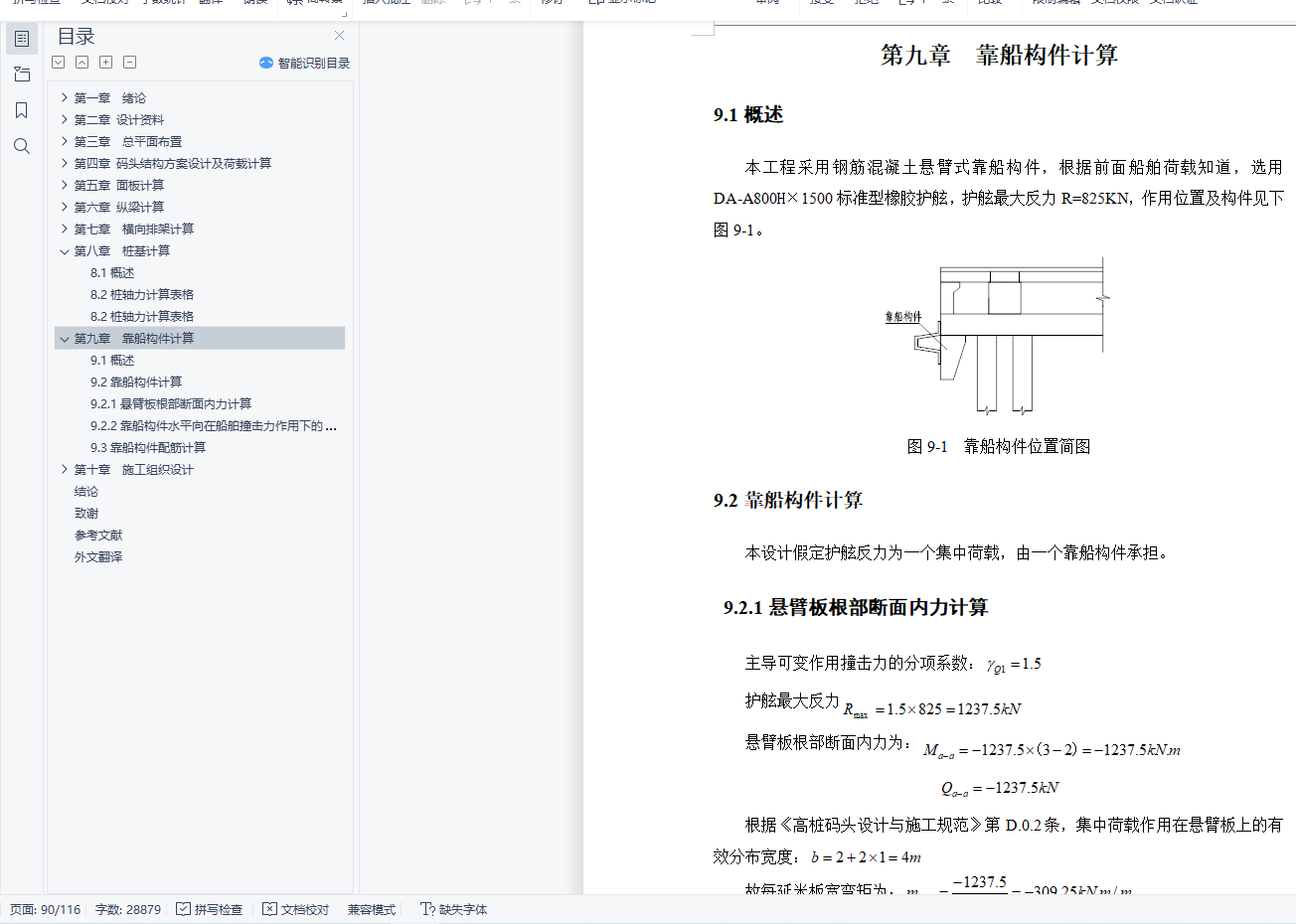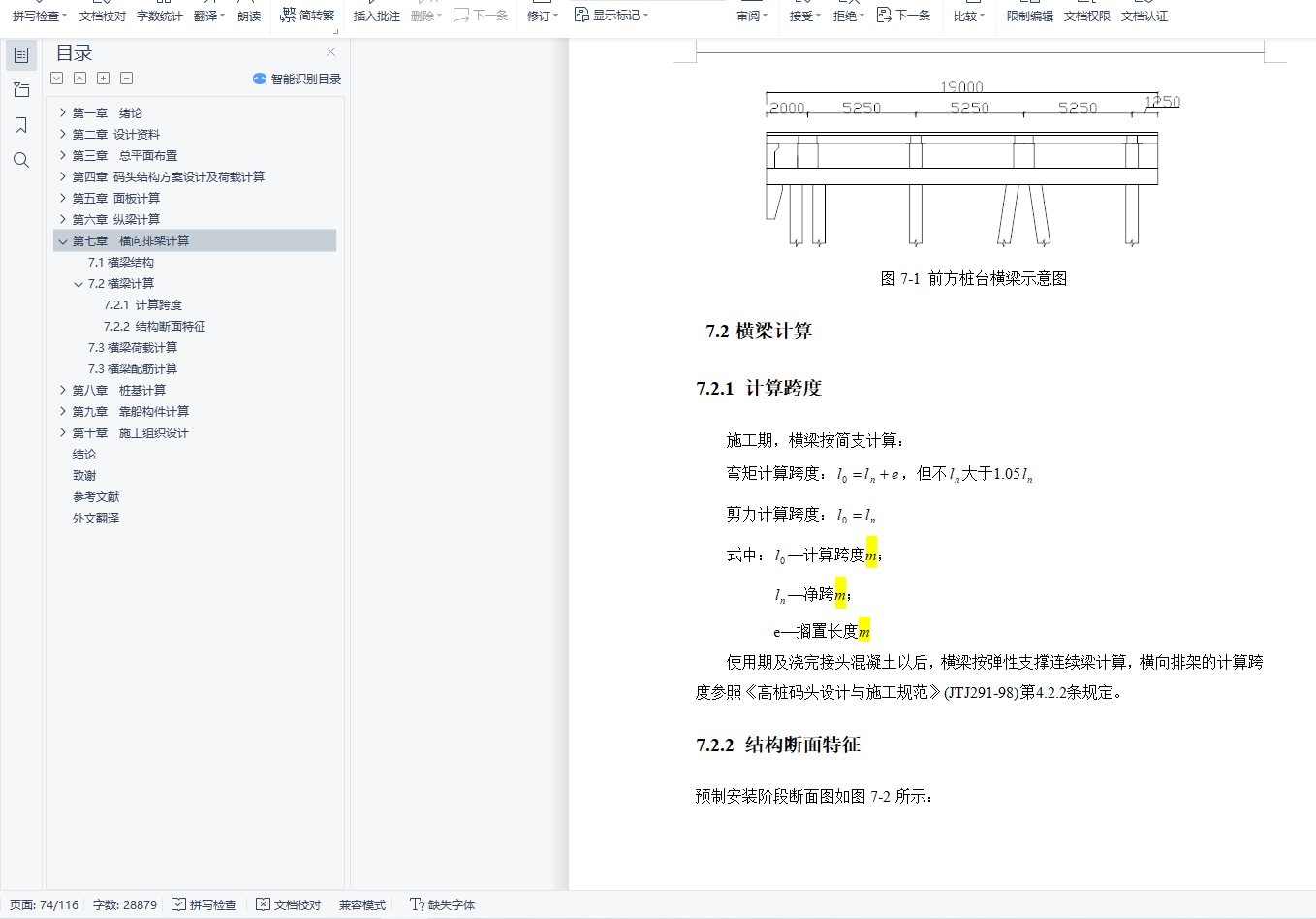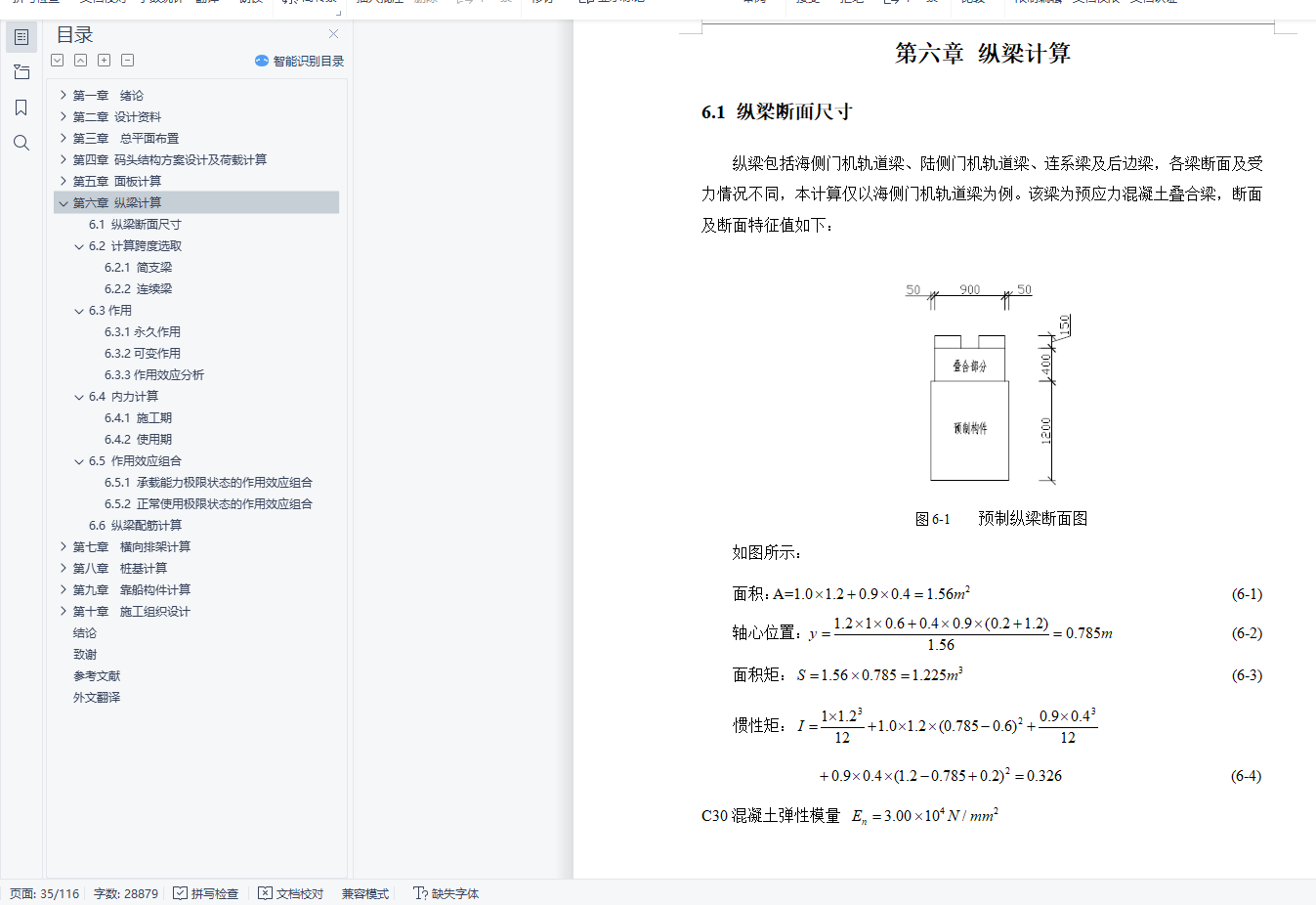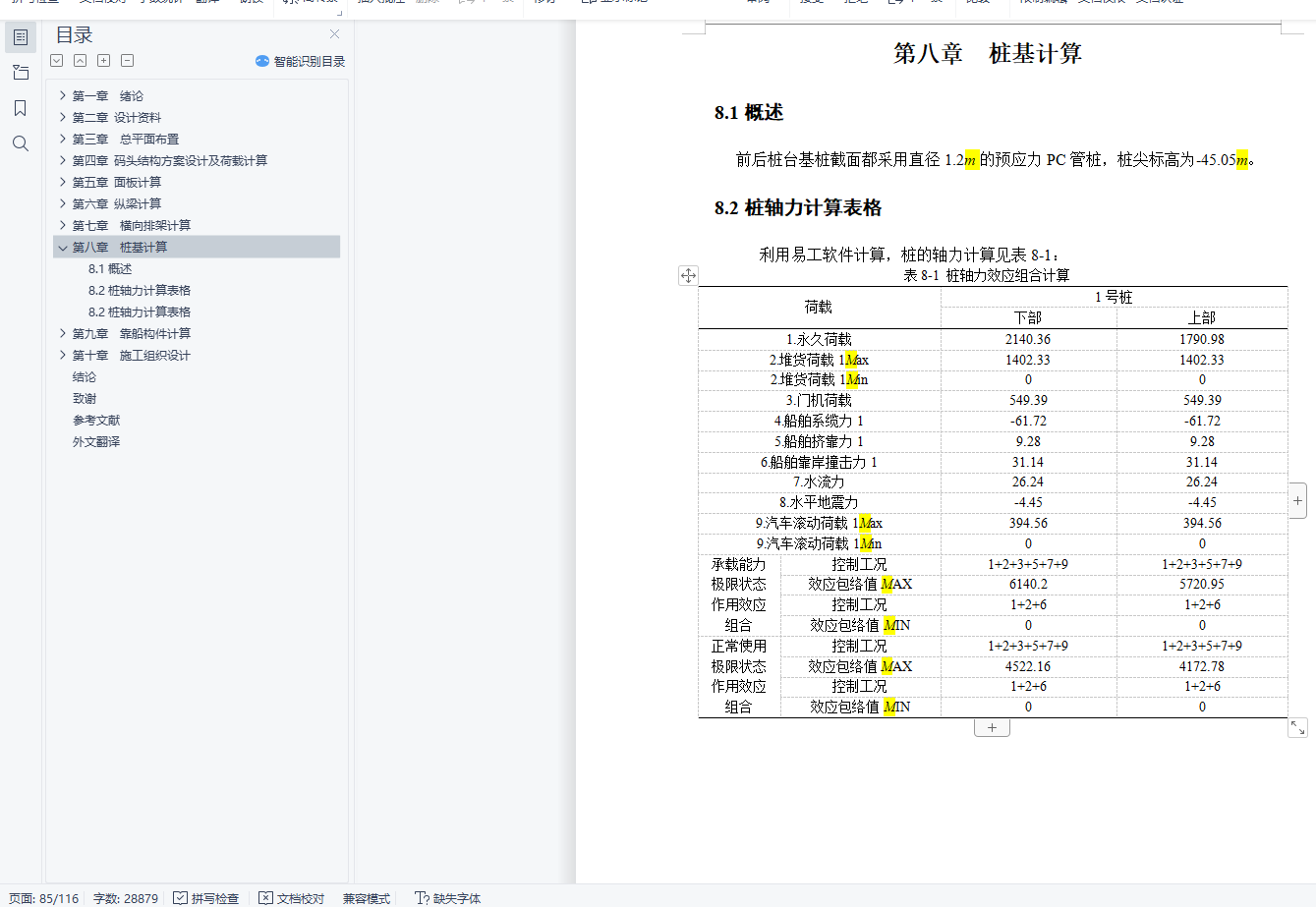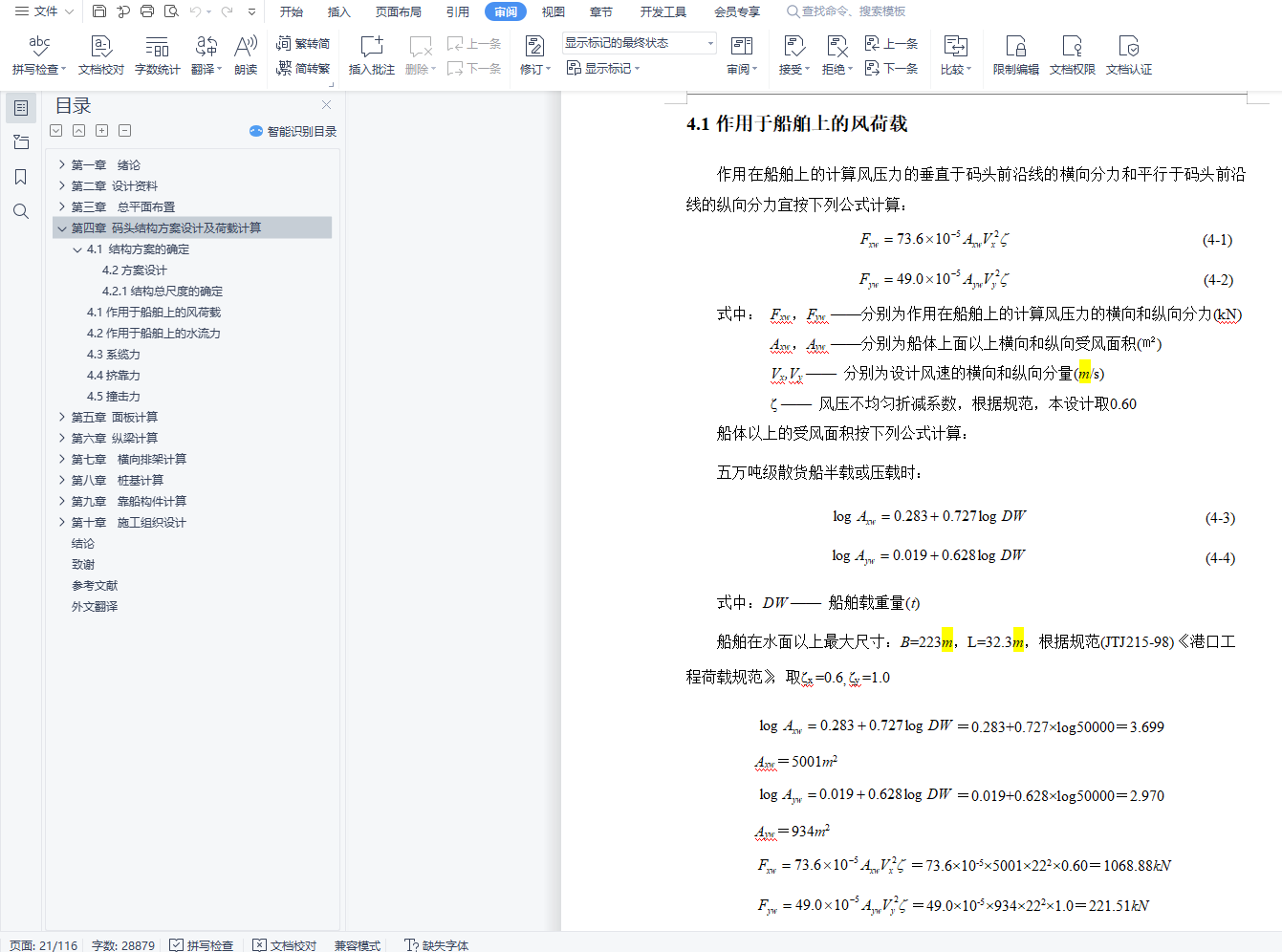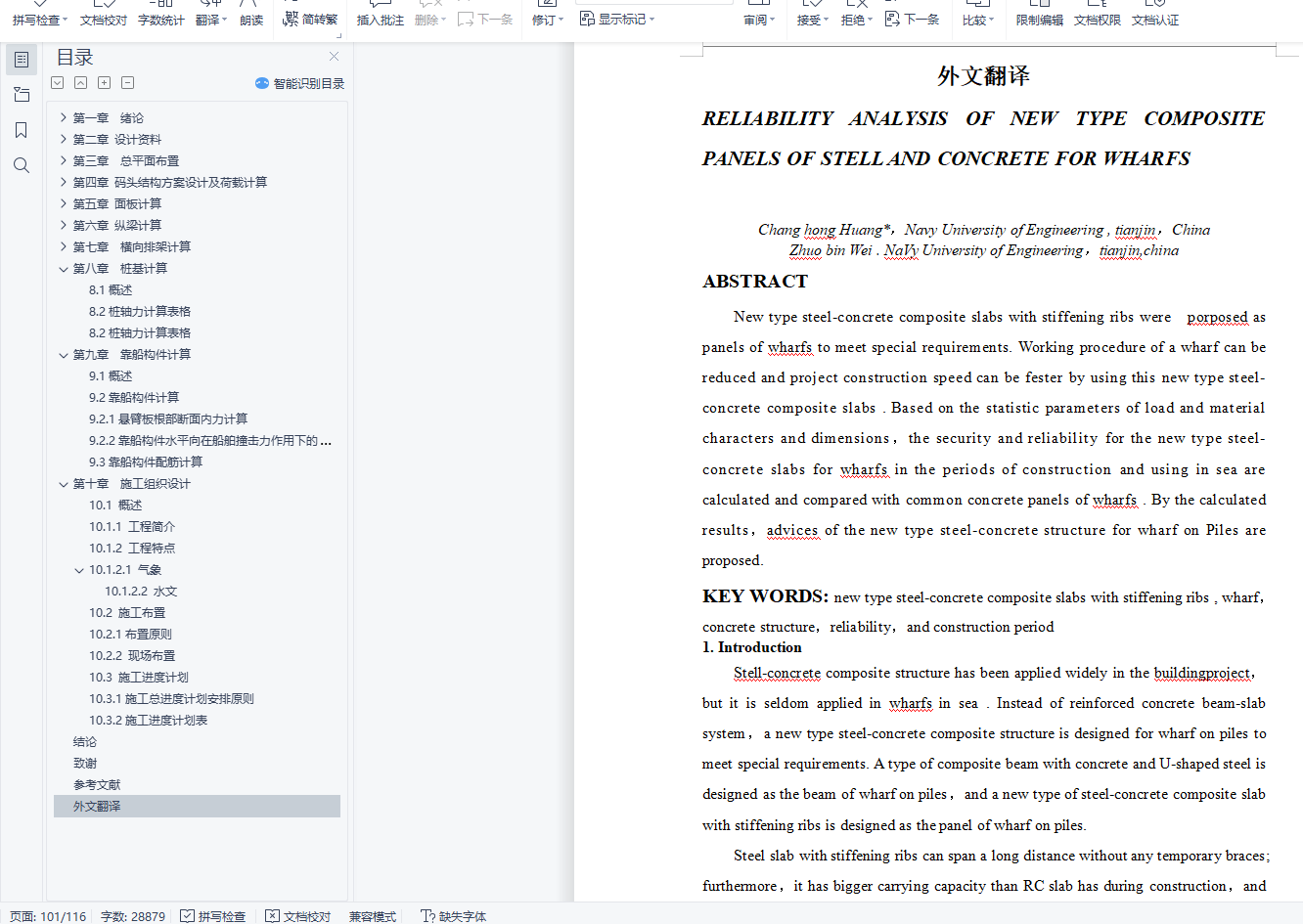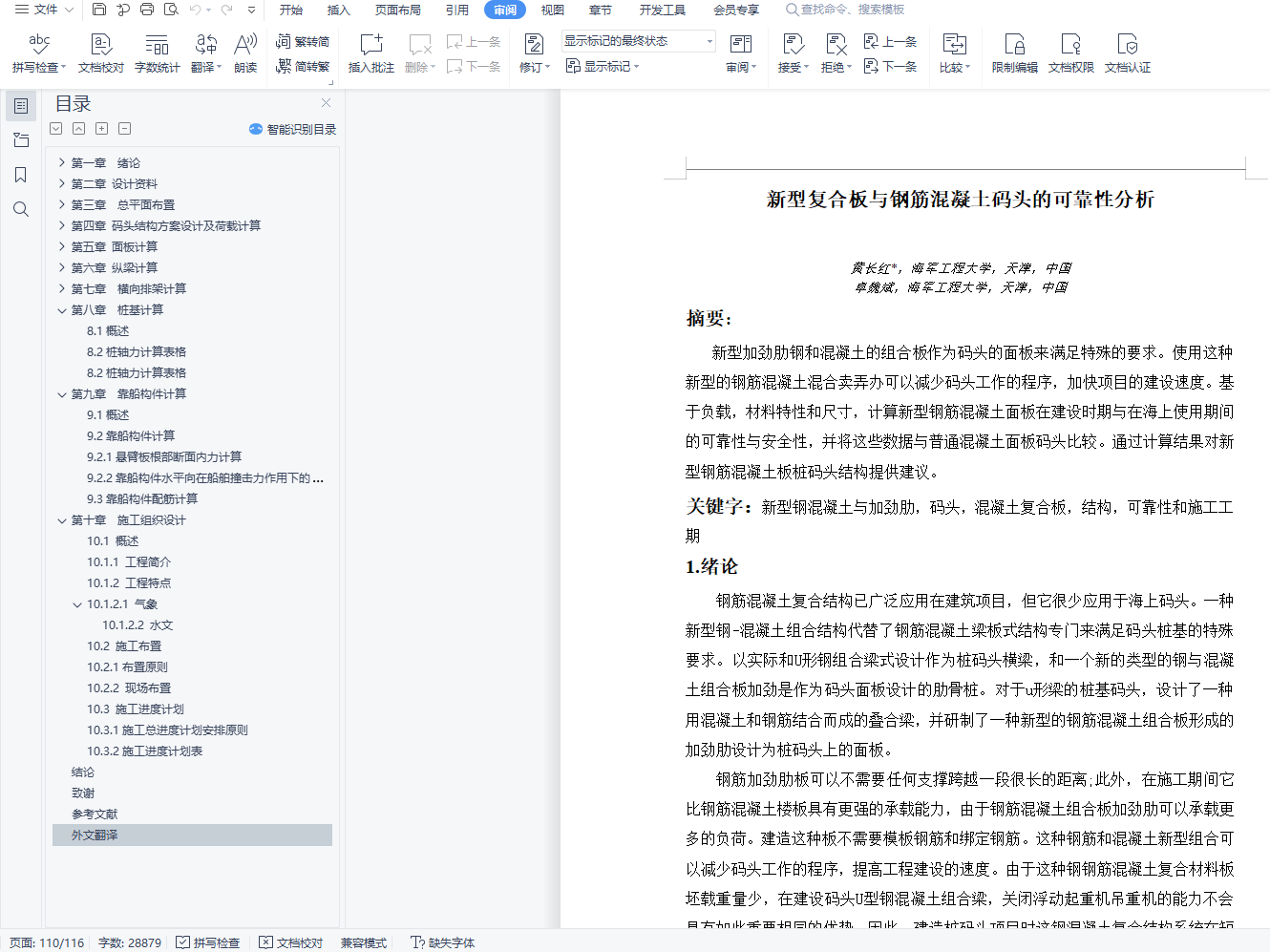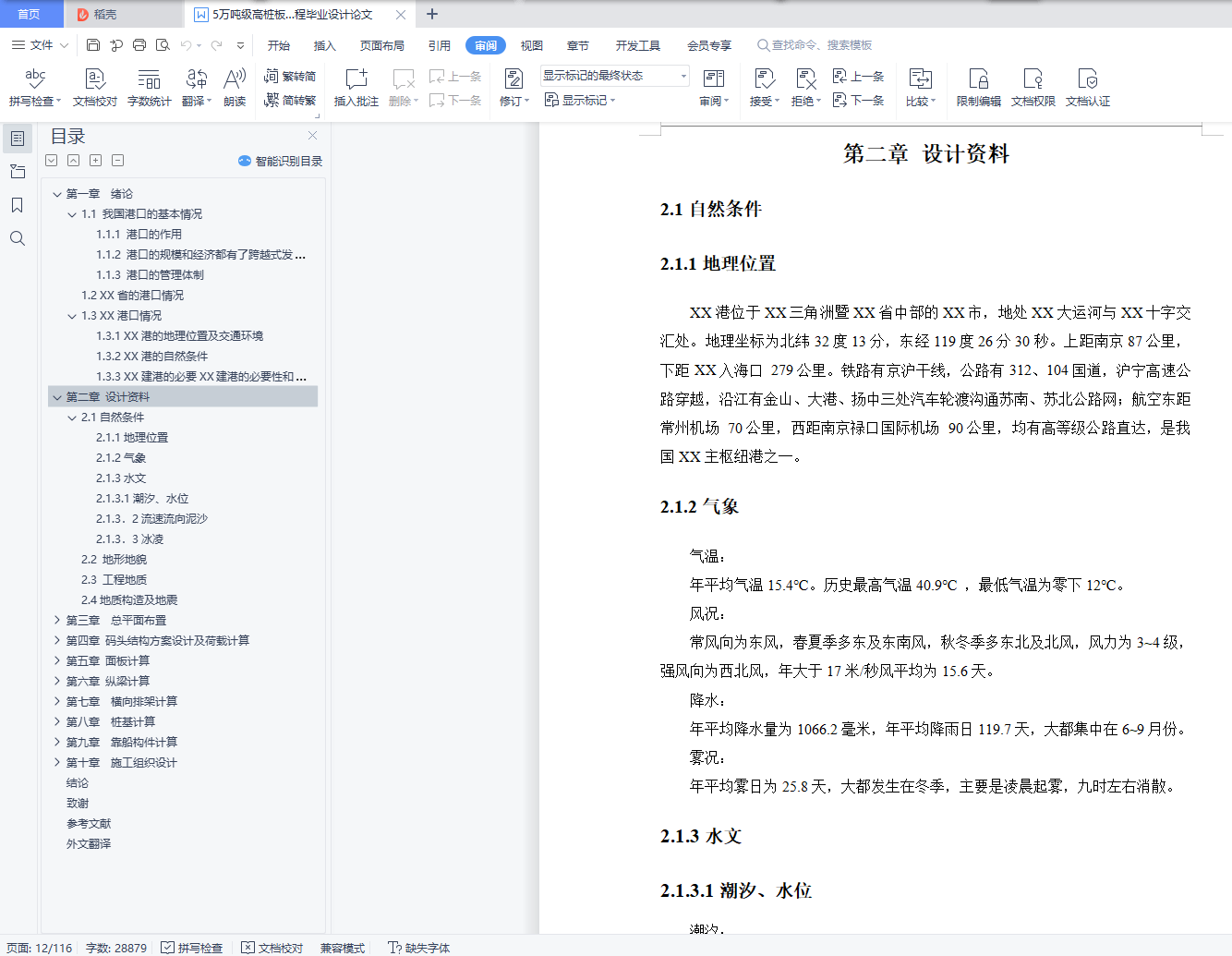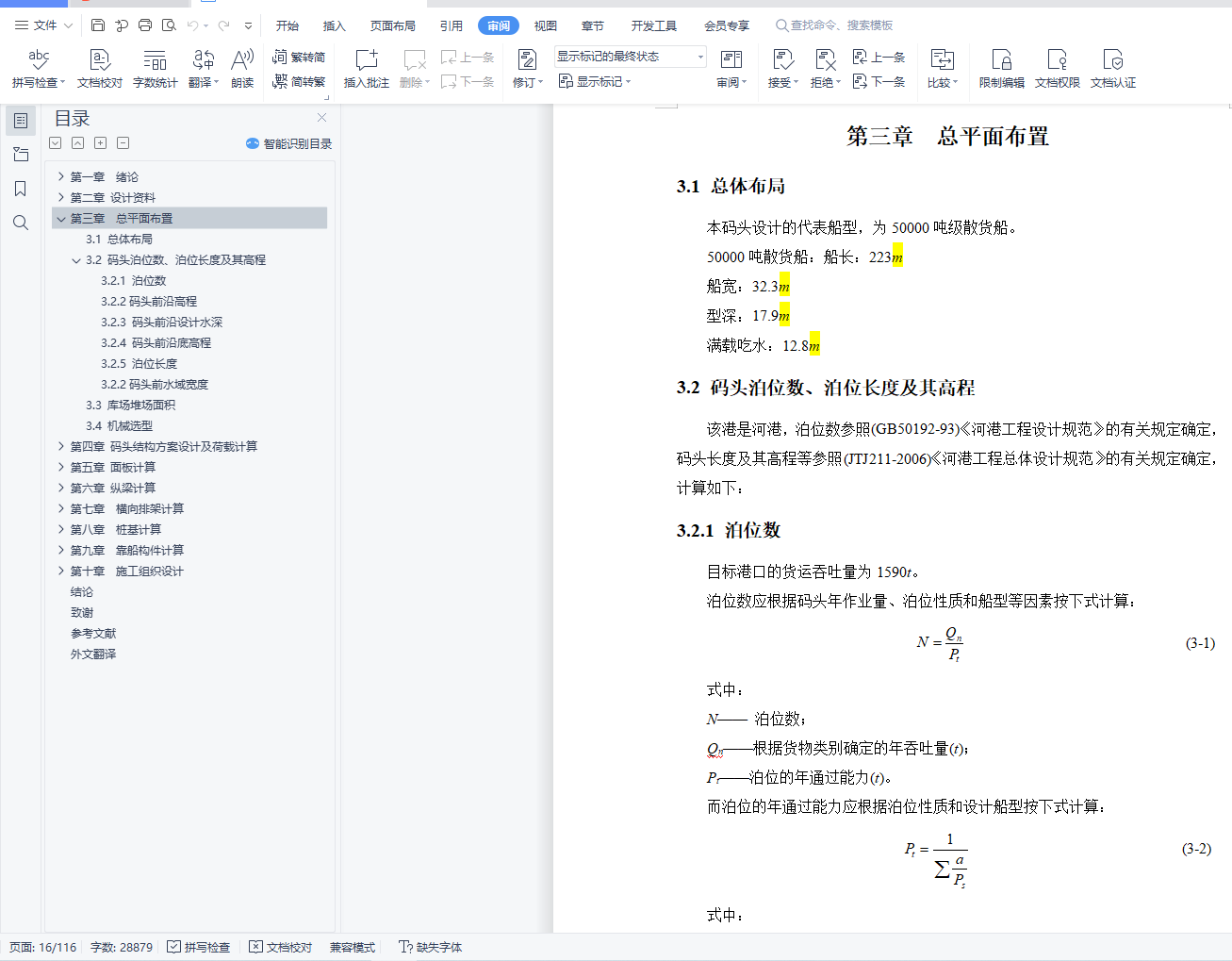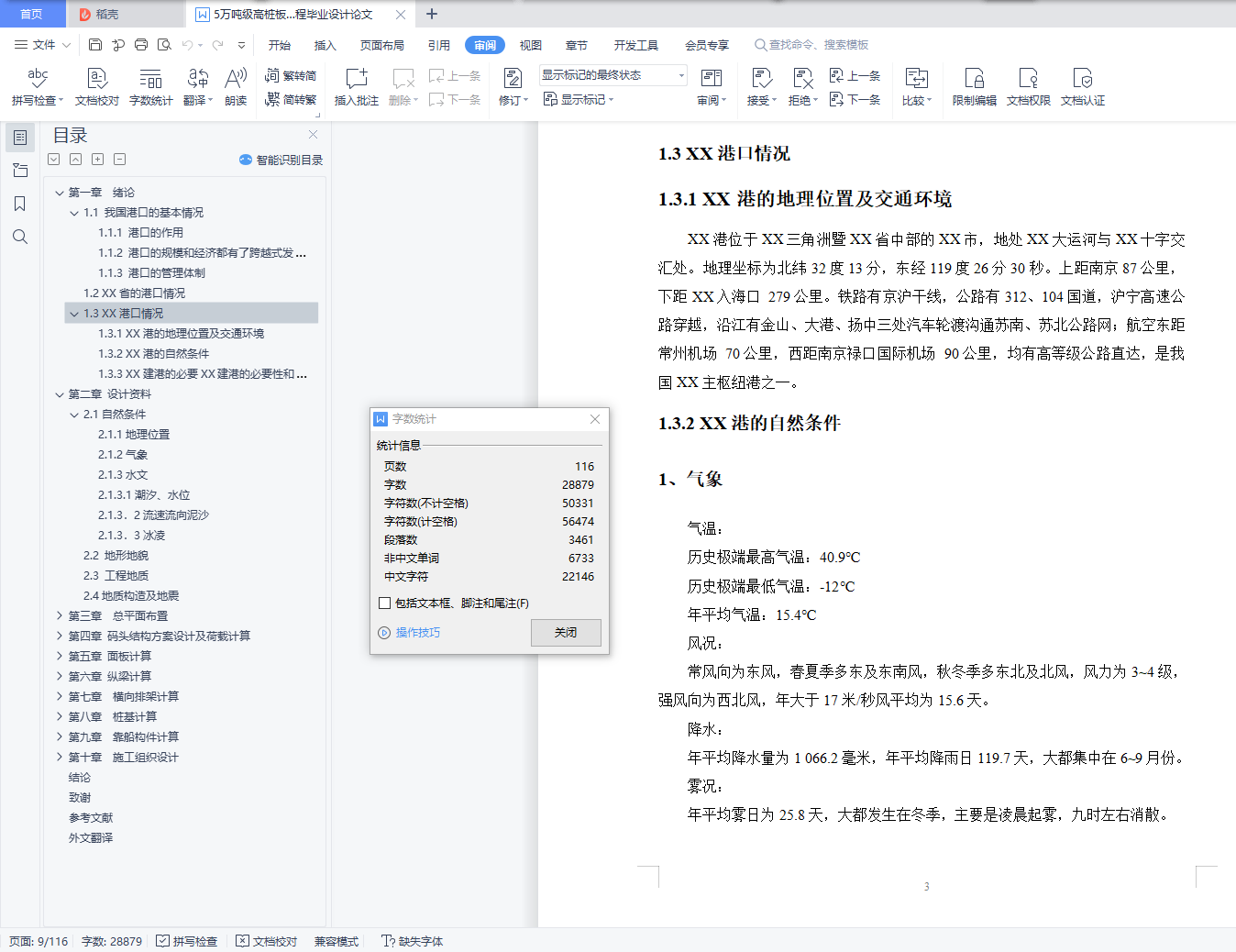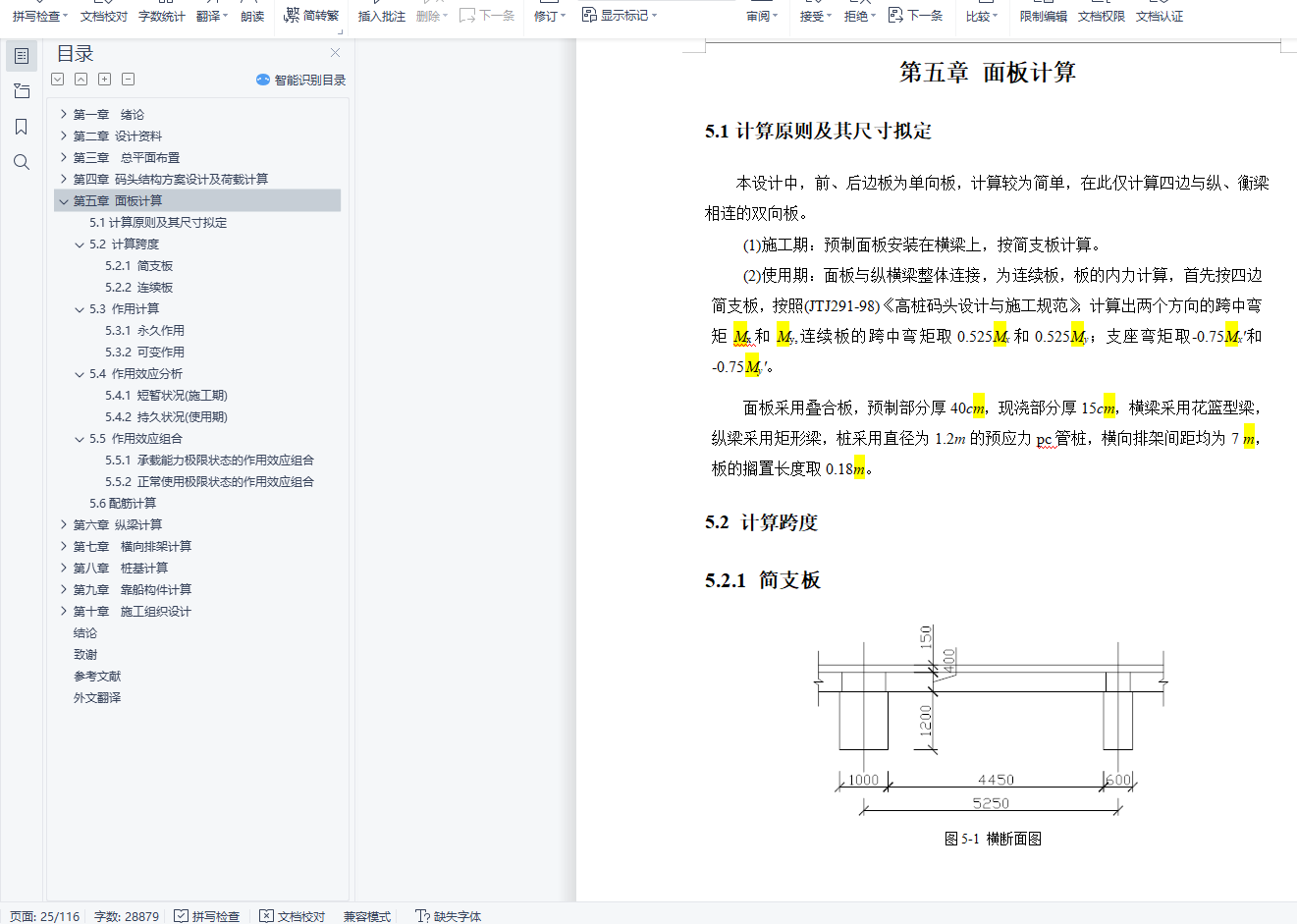摘要
该论文为XX港高桩板梁式码头设计,地处XX大运河与XX十字交汇处,是我国XX主枢纽港之一。该地所处的地质条件基本为淤泥,适合使用高桩码头这种结构型式,高桩码头结构自重轻,为透空结构,可以减弱波浪对码头的影响。
本设计主要分XX港5万吨级板梁式高桩码头,主要分为四大部分:
第一、根据当地实际情况对码头进行了结构选型,总平面做了布置,包括码头前沿水深、码头面高程、泊位长度等,此外,根据相关规范,对码头的各构件尺寸进行了估算。
第二、对所承受的荷载以及各构件进行了计算,这部分是本设计的核心内容,包括对面板、纵梁、横向排架、桩基和靠船构件的详细计算,其中横向排架和桩基采用上海易工软件进行了计算。
第三、进行了简单的施工组织设计,包括工程简介、场地安排和施工进度计划三部分。
第四、对码头各断面,包括各构件进行了CAD绘图。
关键词:高桩;板粱式;结构;内力计算
Abstract
The paper pile board in Zhenjiang port high beam terminal design, located in the Beijing-Hangzhou Grand Canal and the Yangtze River Cross Interchange, is the main hub of China's Yangtze River. The manner in which the basic geological conditions for the sludge, suitable for high-piled wharf of this structure type, high-pile wharf structure, light weight, for the permeable structure, can weaken the impact of waves on the pier.
The design of the main points of Zhenjiang port 50,000 t-class plate beam wharf, divided into four parts:
First, according to local actual situation on the terminals of the structure of selection, the total plane made a layout, including the front dock water depth, the terminal surface elevation, berth length, in addition, according to the relevant norms, on terminals were estimated size of each component.
Second, the loads and the components were calculated, this part is the core of this design, including the panel, longitudinal, transverse bent, pile foundation and the detailed calculations by ship components, including Transverse and easy to work with Shanghai pile calculation software.
Third, for the simple construction design, including project profiles, venue arrangements and the construction schedule of three parts.
Fourth, the section of the pier, including the components were CAD drawing.
Keywords: high piled wharf; beams plate; structure ; internal force calculation
第一章 绪论
1.1 我国港口的基本情况
1.1.1 港口的作用
1.1.2 港口的规模和经济都有了跨越式发展
1.1.3 港口的管理体制
1.2 XX省的港口情况
1.3 XX港口情况
1.3.1 XX港的地理位置及交通环境
1.3.2 XX港的自然条件
1.3.3 XX建港的必要XX建港的必要性和重要性
第二章 设计资料
2.1自然条件
2.1.1地理位置
2.1.2气象
2.1.3水文
2.1.3.1潮汐、水位
2.1.3.2流速流向泥沙
2.1.3.3冰凌
2.2 地形地貌
2.3 工程地质
2.4地质构造及地震
第三章 总平面布置
3.1 总体布局
3.2 码头泊位数、泊位长度及其高程
3.2.1 泊位数
3.2.2码头前沿高程
3.2.3 码头前沿设计水深
3.2.4 码头前沿底高程
3.2.5 泊位长度
3.2.2码头前水域宽度
3.3 库场堆场面积
3.4 机械选型
第四章 码头结构方案设计及荷载计算
4.1 结构方案的确定
4.2方案设计
4.2.1结构总尺度的确定
4.1作用于船舶上的风荷载
4.2作用于船舶上的水流力
4.3系缆力
4.4挤靠力
4.5撞击力
第五章 面板计算
5.1计算原则及其尺寸拟定
5.2 计算跨度
5.2.1 简支板
5.2.2 连续板
5.3 作用计算
5.3.1 永久作用
5.3.2 可变作用
5.4 作用效应分析
5.4.1 短暂状况(施工期)
5.4.2 持久状况(使用期)
5.5 作用效应组合
5.5.1 承载能力极限状态的作用效应组合
5.5.2 正常使用极限状态的作用效应组合
5.6配筋计算
第六章 纵梁计算
6.1 纵梁断面尺寸
6.2 计算跨度选取
6.2.1 简支梁
6.2.2 连续梁
6.3作用
6.3.1永久作用
6.3.2可变作用
6.3.3作用效应分析
6.4 内力计算
6.4.1 施工期
6.4.2 使用期
6.5 作用效应组合
6.5.1 承载能力极限状态的作用效应组合
6.5.2 正常使用极限状态的作用效应组合
6.6 纵梁配筋计算
第七章 横向排架计算
7.1横梁结构
7.2横梁计算
7.2.1 计算跨度
7.2.2 结构断面特征
7.3横梁荷载计算
7.3横梁配筋计算
第八章 桩基计算
8.1概述
8.2桩轴力计算表格
8.2桩轴力计算表格
第九章 靠船构件计算
9.1概述
9.2靠船构件计算
9.2.1悬臂板根部断面内力计算
9.2.2靠船构件水平向在船舶撞击力作用下的内力
9.3靠船构件配筋计算
第十章 施工组织设计
10.1 概述
10.1.1 工程简介
10.1.2 工程特点
10.1.2.1 气象
10.1.2.2 水文
10.2 施工布置
10.2.1布置原则
10.2.2 现场布置
10.3 施工进度计划
10.3.1施工总进度计划安排原则
10.3.2施工进度计划表
结论
致谢
参考文献
外文翻译
